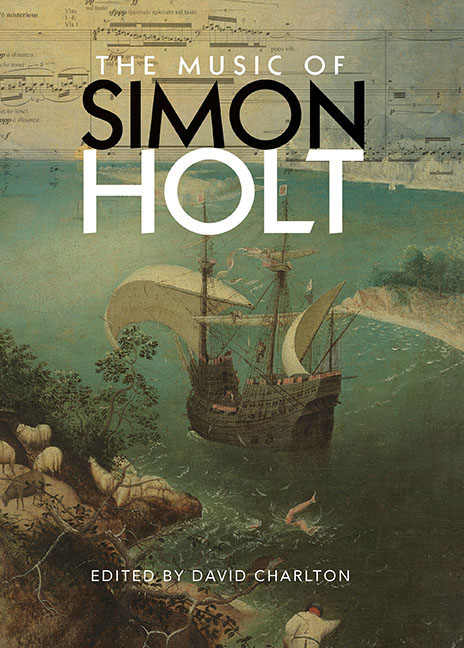Book contents
- Frontmatter
- Contents
- Figures and Tables
- Contributors
- Preface and Acknowledgements
- Abbreviations, with a note on recordings and scores
- Introduction Memories of Magical Moonlight: Simon Holt's years as a composition student
- 1 Duende y Duelos: The Andalusian spirit in the Lorca settings
- 2 An Interplay of Passion and Spirit: The Nightingale's to Blame
- 3 Images in Sound: Movement, harmony and colour in the early music
- 4 Myth and Narrative in 3 for Icarus
- 5 Sound, Sense and Syntax: The Emily Dickinson settings
- 6 Piano Music
- 7 Redefining the Cello's Voice: Musical agency in feet of clay
- 8 Performance and Reflections: Holt's music for oboe and cor anglais
- 9 Shaking the Bars: The Yellow Wallpaper
- 10 Listening to the River's Roar: Stance, texture and space in the concertos
- 11 Orchestral Works in Performance
- 12 Oblique Themes and Still Centres: A conversation between
- 13 Sketching and Idea-Gathering
- 14 Art, Conceptualism and Politics in Holt's music
- Appendix A Overview and Catalogue of Pieces
- Appendix B Texts by Simon Holt for Raju Raghuvanshi is a ghost and The Legend of Melusine
- Bibliography
- Index of pieces by Simon Holt
- General index
5 - Sound, Sense and Syntax: The Emily Dickinson settings
Published online by Cambridge University Press: 01 September 2018
- Frontmatter
- Contents
- Figures and Tables
- Contributors
- Preface and Acknowledgements
- Abbreviations, with a note on recordings and scores
- Introduction Memories of Magical Moonlight: Simon Holt's years as a composition student
- 1 Duende y Duelos: The Andalusian spirit in the Lorca settings
- 2 An Interplay of Passion and Spirit: The Nightingale's to Blame
- 3 Images in Sound: Movement, harmony and colour in the early music
- 4 Myth and Narrative in 3 for Icarus
- 5 Sound, Sense and Syntax: The Emily Dickinson settings
- 6 Piano Music
- 7 Redefining the Cello's Voice: Musical agency in feet of clay
- 8 Performance and Reflections: Holt's music for oboe and cor anglais
- 9 Shaking the Bars: The Yellow Wallpaper
- 10 Listening to the River's Roar: Stance, texture and space in the concertos
- 11 Orchestral Works in Performance
- 12 Oblique Themes and Still Centres: A conversation between
- 13 Sketching and Idea-Gathering
- 14 Art, Conceptualism and Politics in Holt's music
- Appendix A Overview and Catalogue of Pieces
- Appendix B Texts by Simon Holt for Raju Raghuvanshi is a ghost and The Legend of Melusine
- Bibliography
- Index of pieces by Simon Holt
- General index
Summary
IN JULY 1862 Emily Dickinson wrote to her recently acquired ‘preceptor’, Thomas Wentworth Higginson: ‘Perhaps you smile at me. I could not stop for that. My business is circumference.’ The remark is typical of her correspondence and of her poetry in being at once candid, concise and elliptical, with an inclination towards what has been described as ‘symbolically freighted words’. In domestic terms, Dickinson's ‘circumference’ was her increasingly reclusive existence ‘at home’ in Amherst, New England, where she was born, lived and died. But in societal terms, Dickinson's devotion to serious writing necessarily entailed her breaking those bounds and the accepted ‘circumference’ of a woman's role. Moreover, by the time she approached Higginson for advice and critical engagement, aged 32, Dickinson had already written over three hundred poems and found an artistic voice that transcended certain poetic conventions. Her ‘business’ amounted to an ongoing exploration of metaphysics through poetry and letters which interrogated the very notion of ‘circumference’, refracted through the lens of everyday personal experience, and related ‘slant-wise’ through strikingly suggestive, emotionally frank imagery.
Dickinson initially sent four poems to her literary counsellor; one of these would prove posthumously to be amongst her most celebrated, and was selected by Simon Holt over 140 years later for the second of his 5 settings of E.D. (2005). After the poet's death in 1886, Higginson confessed to never having lost the feeling of being ‘somewhat bewildered’ by Dickinson's ‘wholly new and original poetic genius’. Not until 1960 did Thomas H. Johnson publish The Complete Poems of Emily Dickinson, rectifying crucial errors in, and omissions from, the earlier edition published by her niece, Martha Dickinson Bianchi, in 1924. These belated publications seem to underline Dickinson's greater affinity with modern art than with that of her own time. Given the progressiveness of her language and form it seems extraordinary that (if we compare music) Debussy was not born until the year when the poet first contacted Higginson. Schoenberg and Charles Ives were born in 1874; Aaron Copland, born in 1900, would set twelve of Dickinson's poems in a cycle for medium voice and piano.
Copland's settings are indicative of certain early- to mid-twentieth-century trends in their neoclassical, tonally-based sparseness of expression.
- Type
- Chapter
- Information
- The Music of Simon Holt , pp. 104 - 127Publisher: Boydell & BrewerPrint publication year: 2017



